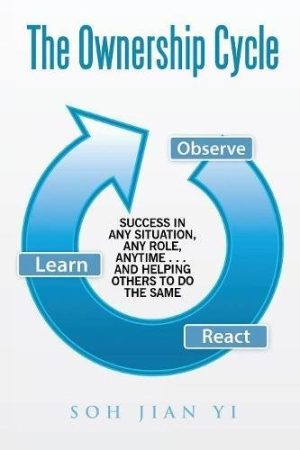It looks like you've stumbled upon a page meant to be read by our code instead of viewed directly. You're probably looking for this page.
The Ownership Cycle
Success in Any Situation, Any Role, Anytime . . . and Helping Others to Do the Same
The Ownership Cycle is well written and thought-provoking, combining a sound theoretical overview of ownership with solid, everyday situations.
Soh Jian Yi’s The Ownership Cycle considers how the concept of ownership can lead to a successful life.
Ownership is often associated with possessing material things, but Soh, a Singaporean physician and university professor, explains that in the broadest sense, ownership is about taking control of one’s own life, “including but not limited to time, energy, effort and mood.” His book explores ownership, which he views as a cycle, in four parts: an introduction; a look at how the cycle applies in a universal sense, in situations such as communication, conflict, and task management; the application of the cycle to specific roles, such as parent, teacher, and volunteer; and then teaching “The Ownership Cycle.”
Soh explains five key aspects of ownership: Role, Awareness, Choices, Consequences, and Future. Throughout the book, examples demonstrate the importance of one or more of the aspects in determining the successful implementation of the ownership cycle. Soh uses text and numerous charts to contrast ownership behaviors with “no-ownership” behaviors. Individuals with a “no-ownership” mentality, writes Soh, may have difficulty distinguishing between needs and wants.
Particularly interesting is the book’s concentration on applying the ownership cycle to real-life situations. In face-to-face communication, for example, ownership is said to revolve around “respect for your audience and yourself,” best demonstrated through knowledge of both the audience and the message, as well as through audience observations and message clarity.
For parents, the ownership cycle facilitates disciplining, persuading, and role-modeling for children. The author offers numerous specific examples of how a parent should take ownership in some situations, and give ownership to the child in other situations. When it comes to one’s own old age or caring for the elderly, Soh provides a useful perspective on how taking ownership can be a grounding principle that makes it easier to accept aging, with specific illustrative examples.
While ownership of one’s life is not a new concept, the book does an admirable job of showing how the notion of ownership versus non-ownership affects everything one does. The author is especially adept at explaining the nuances of ownership as it applies to the many roles one plays, as well as to various phases of life. The final part of the book is essentially a short guide to teaching oneself about ownership, and helping those mired in a “no-ownership” mentality to learn about ownership. Ultimately, the author writes, “Ownership of the future is what allows you to dream.”
The Ownership Cycle is well written and thought-provoking. It combines a sound theoretical overview of ownership with solid, everyday situations that advance the discussion of the topic.
Reviewed by
Barry Silverstein
Disclosure: This article is not an endorsement, but a review. The publisher of this book provided free copies of the book and paid a small fee to have their book reviewed by a professional reviewer. Foreword Reviews and Clarion Reviews make no guarantee that the publisher will receive a positive review. Foreword Magazine, Inc. is disclosing this in accordance with the Federal Trade Commission’s 16 CFR, Part 255.
